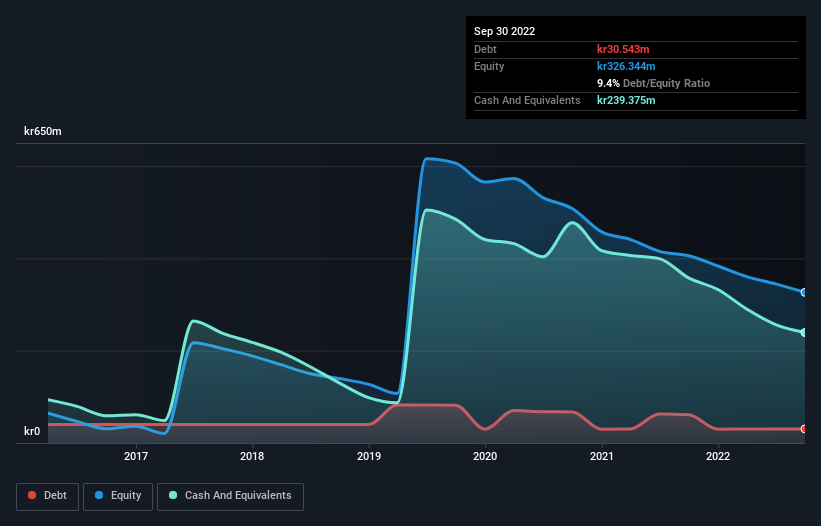
Howard Marks put it nicely when he said that, rather than worrying about share price volatility, 'The possibility of permanent loss is the risk I worry about... and every practical investor I know worries about.' It's only natural to consider a company's balance sheet when you examine how risky it is, since debt is often involved when a business collapses. As with many other companies PowerCell Sweden AB (publ) (STO:PCELL) makes use of debt. But the more important question is: how much risk is that debt creating?
When Is Debt Dangerous?
Debt assists a business until the business has trouble paying it off, either with new capital or with free cash flow. In the worst case scenario, a company can go bankrupt if it cannot pay its creditors. However, a more usual (but still expensive) situation is where a company must dilute shareholders at a cheap share price simply to get debt under control. Having said that, the most common situation is where a company manages its debt reasonably well - and to its own advantage. The first thing to do when considering how much debt a business uses is to look at its cash and debt together.
View our latest analysis for PowerCell Sweden
How Much Debt Does PowerCell Sweden Carry?
You can click the graphic below for the historical numbers, but it shows that PowerCell Sweden had kr30.5m of debt in September 2022, down from kr61.2m, one year before. However, its balance sheet shows it holds kr239.4m in cash, so it actually has kr208.8m net cash.

A Look At PowerCell Sweden's Liabilities
The latest balance sheet data shows that PowerCell Sweden had liabilities of kr84.9m due within a year, and liabilities of kr56.2m falling due after that. On the other hand, it had cash of kr239.4m and kr65.2m worth of receivables due within a year. So it actually has kr163.5m more liquid assets than total liabilities.
This short term liquidity is a sign that PowerCell Sweden could probably pay off its debt with ease, as its balance sheet is far from stretched. Simply put, the fact that PowerCell Sweden has more cash than debt is arguably a good indication that it can manage its debt safely. There's no doubt that we learn most about debt from the balance sheet. But ultimately the future profitability of the business will decide if PowerCell Sweden can strengthen its balance sheet over time. So if you want to see what the professionals think, you might find this free report on analyst profit forecasts to be interesting.
Over 12 months, PowerCell Sweden reported revenue of kr200m, which is a gain of 42%, although it did not report any earnings before interest and tax. With any luck the company will be able to grow its way to profitability.
So How Risky Is PowerCell Sweden?
We have no doubt that loss making companies are, in general, riskier than profitable ones. And in the last year PowerCell Sweden had an earnings before interest and tax (EBIT) loss, truth be told. Indeed, in that time it burnt through kr121m of cash and made a loss of kr85m. Given it only has net cash of kr208.8m, the company may need to raise more capital if it doesn't reach break-even soon. PowerCell Sweden's revenue growth shone bright over the last year, so it may well be in a position to turn a profit in due course. Pre-profit companies are often risky, but they can also offer great rewards. The balance sheet is clearly the area to focus on when you are analysing debt. However, not all investment risk resides within the balance sheet - far from it. For example, we've discovered 1 warning sign for PowerCell Sweden that you should be aware of before investing here.
At the end of the day, it's often better to focus on companies that are free from net debt. You can access our special list of such companies (all with a track record of profit growth). It's free.
New: Manage All Your Stock Portfolios in One Place
We've created the ultimate portfolio companion for stock investors, and it's free.
• Connect an unlimited number of Portfolios and see your total in one currency
• Be alerted to new Warning Signs or Risks via email or mobile
• Track the Fair Value of your stocks
Have feedback on this article? Concerned about the content? Get in touch with us directly. Alternatively, email editorial-team (at) simplywallst.com.
This article by Simply Wall St is general in nature. We provide commentary based on historical data and analyst forecasts only using an unbiased methodology and our articles are not intended to be financial advice. It does not constitute a recommendation to buy or sell any stock, and does not take account of your objectives, or your financial situation. We aim to bring you long-term focused analysis driven by fundamental data. Note that our analysis may not factor in the latest price-sensitive company announcements or qualitative material. Simply Wall St has no position in any stocks mentioned.
About OM:PCELL
PowerCell Sweden
Develops and produces fuel cells and fuel cell systems for automotive, marine, and stationary applications in Sweden and internationally.
High growth potential with adequate balance sheet.
Similar Companies
Market Insights
Community Narratives




